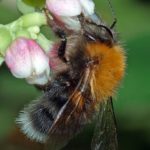Track expansion in two bumblebees
Tree bumblebee (Bombus hypnorum)
- Distinctive bumblebee best identified by it’s white tail and all ginger thorax
- Following many suspected sightings, the first specimen was recorded in Ireland in September 2017. It was found in St Stephen’s Green, Dublin.
-
Unlike all our other bumblebees who make their nest at ground level this one nests above ground in tree holes and other suitable structures including empty bird boxes.
- It is moving northwards as a result of climate change. It has only been a decade since the Tree Bumblebee arrived in southern England from France and in that time it has spread at a rate of over 4,500 square miles a year – and area almost the size of Northern Ireland.
- Ireland is the only country to have an established Bumblebee Monitoring Scheme in place before its arrival. This puts us in a unique position to track the impact of its arrival on existing bumblebee species.
-
Can you help track its expansion? Please keep an eye out and submit your sightings whenever you spot this species. Given that it is still so rare we would ask that a photograph be included where possible Submit sightings
Mountain bumblebee (Bombus monticola)
- Distinctive bumblebee best identified by the large area of orange-red hairs on its abdomen (only the first segment of the abdomen is black)
- First recorded in Ireland in the 1970’s from the Dublin/Wicklow Mountains, and then from Northern Ireland in the 1980’s (Co. Tyrone and from a range of locations on the Antrim Coast). It is assumed that it colonised Wicklow/Dublin from populations in Wales, and arrived in the North from populations in Scotland.
- It is a habitat specialist, generally being associated with bogs/heaths at higher altitudes where it likes to feed on Blaeberry/Bilberry (Vaccinium myrtillus).
- Can you find new populations in Northern Ireland? Since 2000, we only have records from Counties Antrim, Derry and Tyrone. It is undoubtedly more common in the North than currently recorded, as there are large areas of very suitable habitat. If you’re in upland areas with Blaeberry have a look and see if you can find new populations.
- Can you help track its expansion in the Republic of Ireland? The southern populations are very healthy and have been expanding gradually southwards. It reached the Blackstairs Mountains in 2004 and was recorded from the area around Brandon Hill in Co. Kilkenny in 2012. In April 2015, we had our first Co. Waterford record. If it reaches the Comeraghs there should be plenty of good habitat and it might eventually make its way down to the south west! Please keep your eyes peeled and let us know if you spot this species. Submit sightings


